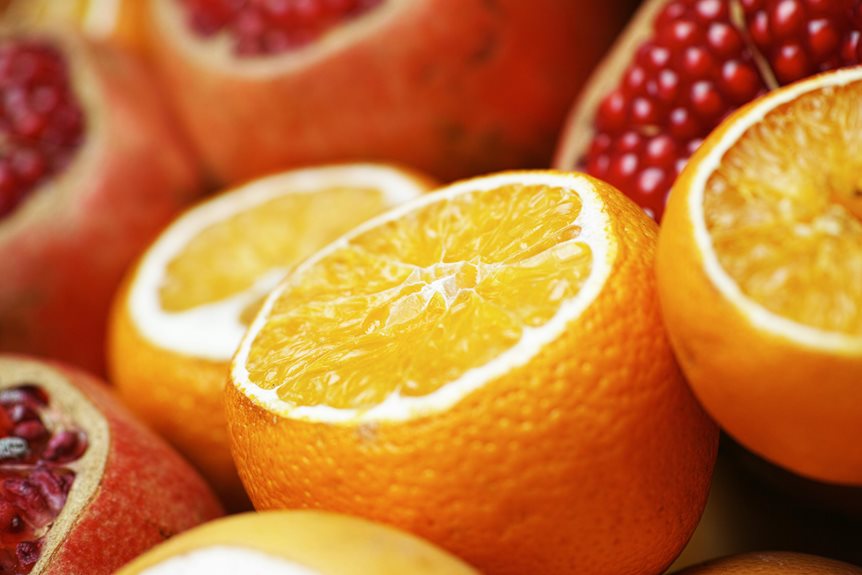Choose Valencia oranges for their high juice yield and bring them to room temperature before juicing. Roll each orange on the counter to break down membranes, or microwave for 10-20 seconds to enhance extraction. You’ll get better results using a wooden reamer or electric juicer for larger batches. Wash fruits thoroughly, cut them in halves, and strain the juice through a fine-mesh sieve for clarity. Proper techniques and tools can transform your home juicing into a professional-level operation.
Selecting the Perfect Oranges for Maximum Juice
Want to get the most juice from your oranges? Start by choosing Valencia oranges, renowned for their exceptional juice yield and sweet flavor. They’re available nearly year-round, with peak season from March to June.
While Navel oranges offer sweetness, consume their juice immediately to avoid bitterness from limonin. Blood oranges provide a unique flavor profile and higher antioxidant content, making them another excellent choice for juicing. Measuring your juice yield percentage helps track extraction efficiency.
For consistent results, select fully ripe fruits, as they’ll yield more liquid. To maximize your juice output, let cold oranges reach room temperature before juicing. Roll them on your counter to break down the internal membranes.
Check that your oranges meet basic ripeness standards – they should feel heavy for their size and have a firm, smooth skin without soft spots.
Essential Tools and Equipment for Orange Juicing
Success in orange juicing starts with having the right tools at your disposal.
Using a traditional wooden citrus reamer offers exceptional control when extracting juice from oranges.
You’ll need to choose between manual and electric options based on your volume requirements. For small batches, a handheld citrus squeezer or the Chef’n FreshForce Plus juicer will serve you well, offering control and efficiency.
For larger quantities, consider electric models like the Cuisinart Citrus Juicer with Carafe or Citristar, which feature adjustable pulp strainers and powerful motors.
Don’t overlook essential prep tools: you’ll need a sharp knife, cutting board, and vegetable brush to clean and halve your oranges.
For storage and straining, keep a large container, funnel, and additional strainers ready. If you’re planning to bottle your juice, add a ladle to your toolkit for precise pouring.
Preparing Your Oranges Before Juicing
Proper preparation of your oranges can dramatically increase juice yield and quality. Start by washing your oranges thoroughly and chilling them in the refrigerator for several hours to firm them up. When you’re ready to juice, let them reach room temperature.
Roll each orange firmly on your counter using light pressure to break down the cell walls inside the fruit. This vital step will maximize your juice extraction. For best results, plan to consume immediately after juicing.
For even better results, microwave each orange for 10-20 seconds or briefly warm them in hot water.
If you’re removing segments, use a sharp knife to peel the oranges and carefully remove any white pith and seeds to prevent bitterness. Cut the oranges into eight slices for easier juicing, or simply halve them if you’re using a manual juicer.
The Room Temperature Advantage
Why are room temperature oranges better for juicing? While oranges should generally be stored in the refrigerator, letting them reach room temperature before juicing will help you extract more juice. You’ll want to remove your oranges from the refrigerator about 30-60 minutes before juicing them.
Just don’t leave your oranges at room temperature for extended periods, as they’ll lose about 6% of their weight and become softer and less juicy over time. Studies show that ultra frozen juice defrosted at room temperature provides optimal nutrient absorption compared to other preparation methods.
Once you’ve juiced your oranges, immediately refrigerate or freeze the juice to preserve its nutrients and prevent bacterial growth. Room temperature storage greatly degrades juice quality, safety, and nutritional value.
For the best results, store your fresh juice at 41°F (5°C), and remember that freezing can preserve it for up to 12-16 months.
Manual vs. Electric Juicing Methods
When choosing between manual and electric juicers for oranges, you’ll need to weigh several key factors like quantity, speed, and effort.
While manual juicers like the Chefn Citrus Juicester are budget-friendly and compact, they’re less efficient for oranges and can strain your hands during extended use.
Electric juicers, particularly models like the Breville Citrus Press, offer superior performance for orange juicing. You’ll extract more juice in less time, making them ideal if you’re processing multiple fruits.
They’re especially valuable when you need consistent results without physical strain.
Consider your specific needs: If you’re only juicing a few oranges occasionally, a manual juicer might suffice.
However, if you regularly juice oranges or need larger quantities, an electric juicer’s higher efficiency and ease of use will justify the investment, despite the higher upfront cost.
Mastering the Rolling Technique
Before juicing your oranges, rolling them on a hard surface can greatly boost your juice yield.
Place the orange under your palm and apply steady, controlled pressure while rolling it back and forth on your kitchen counter. You’ll want enough force to soften the fruit but not so much that you release oils from the peel. What started as a skeptical kitchen tip has proven to be incredibly effective for countless home cooks.
For best results, roll your oranges at room temperature, as they’ll produce more juice than cold ones.
This technique works by breaking down the internal membranes of the fruit, making juice extraction more efficient. You’ll also find the peel comes off more easily after rolling.
While this method won’t create additional juice, it will help you extract the maximum amount from your fruit.
Apply this technique to any citrus fruit before cutting or mechanical juicing.
Straining and Filtering Your Orange Juice
Two vital steps in creating smooth, delicious orange juice are straining and filtering.
Position your juice strainer or fine-mesh sieve securely over a bowl, then pour in your freshly squeezed juice. Use a spoon to press and move the pulp around, extracting maximum juice while leaving behind unwanted seeds and bitter pith.
For the smoothest results, you’ll want to filter your juice a second time through a fine-mesh strainer. This extra step removes any remaining pulp or seeds that slipped through initially. Let your oranges reach room temperature first to ensure you extract the most juice during the initial pressing.
If you’re using a blender method, this filtering becomes even more essential. Don’t forget to strain immediately after extraction to preserve freshness and nutrients.
You can also use cheesecloth or a clean cotton cloth as an alternative filtering method for best clarity.
Natural Flavor Enhancers and Add-ins
After straining your orange juice to perfection, you can enhance its natural flavors with several complementary ingredients.
Start by selecting the right orange varietals – Valencia oranges offer superior sweetness and color, while avoiding navel oranges helps prevent bitter notes from limonin.
You’ll get the best results by adding natural orange oil, which you can incorporate at 0.1% concentration for fresh juice.
To create unique flavor profiles, try blending your orange juice with other citrus fruits, particularly clementines, which add bright, tangy notes while maintaining the natural sweetness. These combinations not only boost flavor but also increase your vitamin C intake. Using products with zero sugar alternatives can help maintain the health benefits while enhancing taste.
For ideal results, make certain you’re using properly ripened oranges harvested at peak flavor, as timing greatly affects the final taste of your juice.
Smart Storage Solutions for Fresh Orange Juice
Since freshly squeezed orange juice has a limited shelf life, proper storage is essential for maintaining its flavor and nutritional benefits.
Store your juice immediately in an airtight container at 40°F (4°C) or below to prevent bacterial growth. You’ll want to keep it away from direct light sources to protect its quality.
For short-term storage, your fresh juice will last 2-3 days in the refrigerator. To extend its life, divide large batches into smaller containers to minimize air exposure when serving. Always check for signs of spoilage like unusual odors or discoloration before consuming stored juice.
For long-term preservation, freeze your juice in freezer-safe containers, leaving room for expansion. You can store frozen juice for up to six months while maintaining its taste and nutritional value.
Consider vacuum sealing to further prevent oxidation, which can extend refrigerated shelf life to about a week.
Creative Ways to Use Orange Pulp and Peels
When juicing oranges, don’t let the leftover pulp and peels go to waste – these often-discarded parts offer countless creative possibilities in both cooking and household uses.
Mix the pulp into your baked goods like muffins, cakes, and cookies to boost moisture, flavor, and fiber content. You can also incorporate it into soups, pasta sauces, or homemade veggie burgers.
For the peels, create candied orange treats or infuse them in vodka for a homemade liqueur. Mix orange pulp with fruit and juice to make delicious fruit pulp crumble topped with oats and nuts.
If you’re not using the pulp in recipes, transform it into practical items like dehydrated crackers or DIY skincare products. The peels can serve as natural moth repellents in your cupboards.
You can also compost both pulp and peels to enrich your garden soil.



Konnichiwa! (Hello!) I'm Pat Tokuyama, a Japanese tofu cookbook author, who travels for music, food, and adventure. If you like Japanese tea, checkout some of the newestorganic japanese tea, matcha bowls and noren and more!
** Curious about the Plant Based Japanese Cooking Club? ** Learn more here!